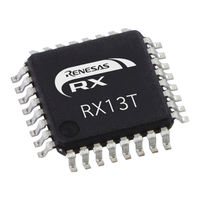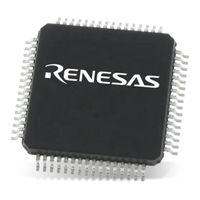Renesas RX100 Series Manuals
Manuals and User Guides for Renesas RX100 Series. We have 7 Renesas RX100 Series manuals available for free PDF download: User Manual
Renesas RX100 Series User Manual (1041 pages)
32-Bit MCU
Brand: Renesas
|
Category: Microcontrollers
|
Size: 14 MB
Table of Contents
-
Features
31 -
Overview
32 -
Cpu
44-
Features44
-
-
Data Types55
-
Endian55
-
Vector Table61
-
Pipeline63
-
Overview63
-
-
-
-
-
Boot Mode77
-
Resets
94 -
-
Overview112
-
-
-
Monitoring Vdet0123
-
Monitoring Vdet1123
-
Monitoring Vdet2123
-
-
-
-
Overview129
-
-
PLL Circuit152
-
Internal Clock152
-
System Clock152
-
Flashif Clock152
-
CAC Clock152
-
-
Usage Notes154
-
-
-
Overview156
-
-
Operation164
-
Usage Notes166
-
-
-
Overview167
-
Usage Notes186
-
-
-
Exception Events189
-
-
-
Overview198
-
-
Vector Table215
-
-
Fast Interrupt227
-
Digital Filter228
-
Usage Note231
-
-
Buses
232-
Overview232
-
Interrupt244
-
Interrupt Source244
-
-
-
-
Overview245
-
-
Request Sources261
-
Operation263
-
Chain Transfer270
-
Operation Timing271
-
DTC Index Table277
-
Interrupt Source289
-
Usage Notes291
-
-
I/O Ports
293-
Overview293
-
-
-
Overview307
-
-
Usage Notes320
-
-
-
Overview322
-
-
Operation387
-
Basic Functions387
-
Buffer Operation395
-
PWM Modes404
-
-
Operation Timing474
-
Usage Notes483
-
-
-
Overview527
-
-
Operation545
-
Interrupts555
-
Usage Notes556
-
-
-
Overview557
-
Operation560
-
Interrupts561
-
Usage Notes562
-
-
-
Overview563
-
Operation572
-
Status Flags579
-
Reset Output579
-
Usage Notes581
-
-
Advertisement
Renesas RX100 Series User Manual (39 pages)
Fast Prototyping Board for RX140 Microcontroller Group
Brand: Renesas
|
Category: Computer Hardware
|
Size: 1 MB
Table of Contents
-
Box Contents11
-
Power18
-
Usb18
-
E2 ob19
-
Ecosystem21
Renesas RX100 Series User Manual (45 pages)
32-Bit MCU; Renesas Starter Kit
Brand: Renesas
|
Category: Computer Hardware
|
Size: 0 MB
Table of Contents
-
1 Overview
11 -
-
-
7 Headers
34 -
-
Overview40
-
Mode Support40
-
Advertisement
Renesas RX100 Series User Manual (43 pages)
Starter Kit For CubeSuite+. RX111 Group
Brand: Renesas
|
Category: Computer Hardware
|
Size: 1 MB
Table of Contents
-
Overview8
-
Purpose8
-
Features8
-
Board Layout10
-
Connectivity13
-
Switches15
-
Leds16
-
Headers31
-
Overview37
-
Mode Support37
Renesas RX100 Series User Manual (43 pages)
32-Bit MCU Starter Kit
Brand: Renesas
|
Category: Microcontrollers
|
Size: 0 MB
Table of Contents
-
Overview9
-
Purpose9
-
Features9
-
Power Supply11
-
Requirements11
-
Board Layout12
-
Connectivity16
-
Switches18
-
Leds19
-
Pmod20
-
Headers33
Renesas RX100 Series User Manual (38 pages)
Starter Kit Code Generator
Brand: Renesas
|
Category: Portable Generator
|
Size: 0 MB
Table of Contents
-
Overview7
-
Purpose7
-
Features7
-
Introduction10
-
I/O Ports14
Renesas RX100 Series User Manual (24 pages)
Target Board, 32-Bit MCU
Brand: Renesas
|
Category: Microcontrollers
|
Size: 0 MB






